Economics Report: Minimum Wage in Australia, Analysis and Impact
VerifiedAdded on 2022/09/16
|11
|2770
|32
Report
AI Summary
This report delves into the economics of minimum wage in Australia, exploring both economic and social arguments for its implementation. It begins by defining minimum wage and its role in the Australian context, referencing the Fair Work Commission's role in setting and adjusting wage standards. The report then presents economic arguments, such as the potential impact on unemployment and household consumption, and social arguments, including its role in poverty reduction and income inequality. Furthermore, it examines the effects of minimum wage on various stakeholders, including the government (welfare spending and job creation), employers (profit margins and hiring practices), and employees (income levels and employment prospects). The report concludes by summarizing the key findings and emphasizing the unique aspects of Australia's minimum wage system and its implications for economic growth and social well-being.
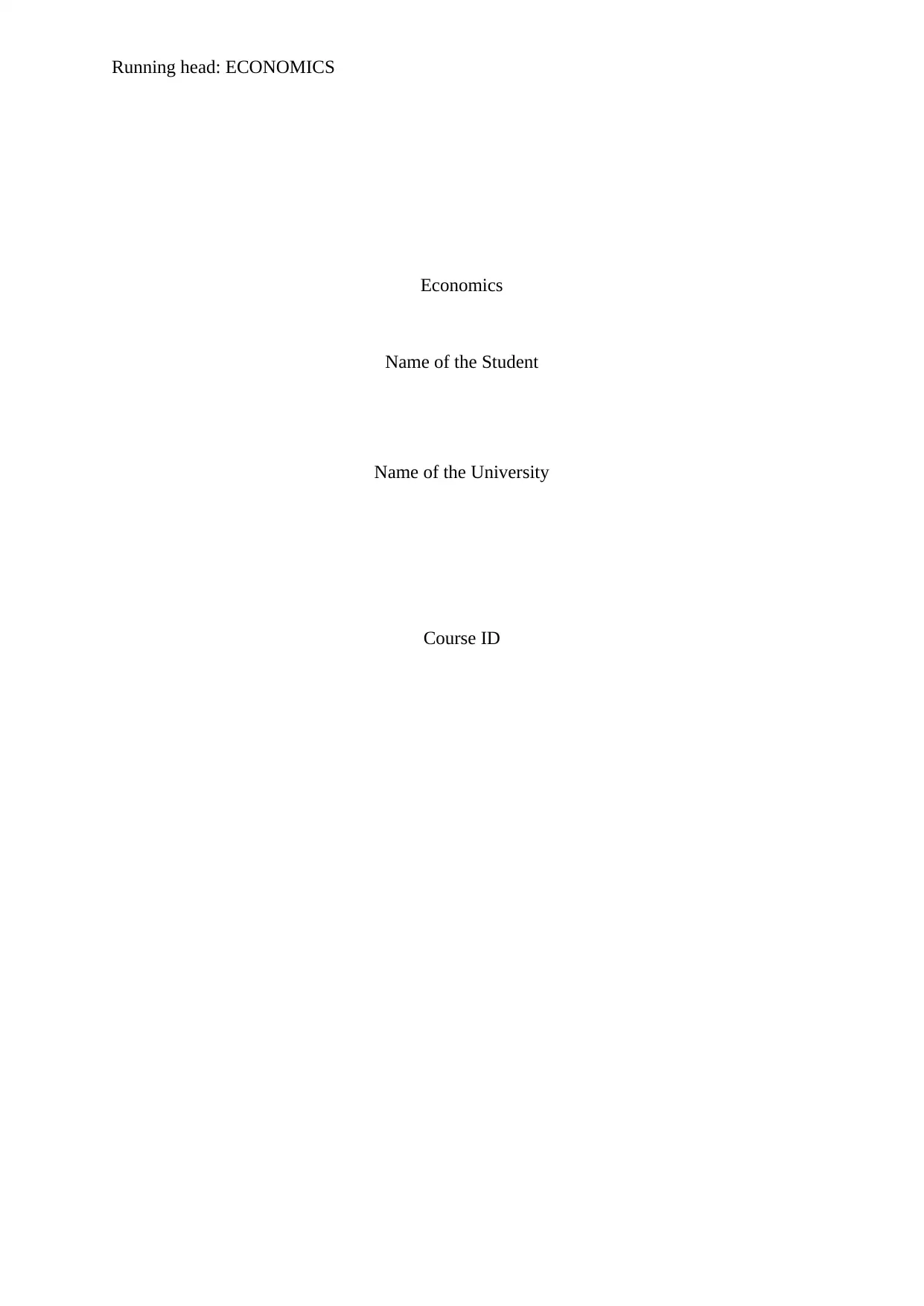
Running head: ECONOMICS
Economics
Name of the Student
Name of the University
Course ID
Economics
Name of the Student
Name of the University
Course ID
Paraphrase This Document
Need a fresh take? Get an instant paraphrase of this document with our AI Paraphraser
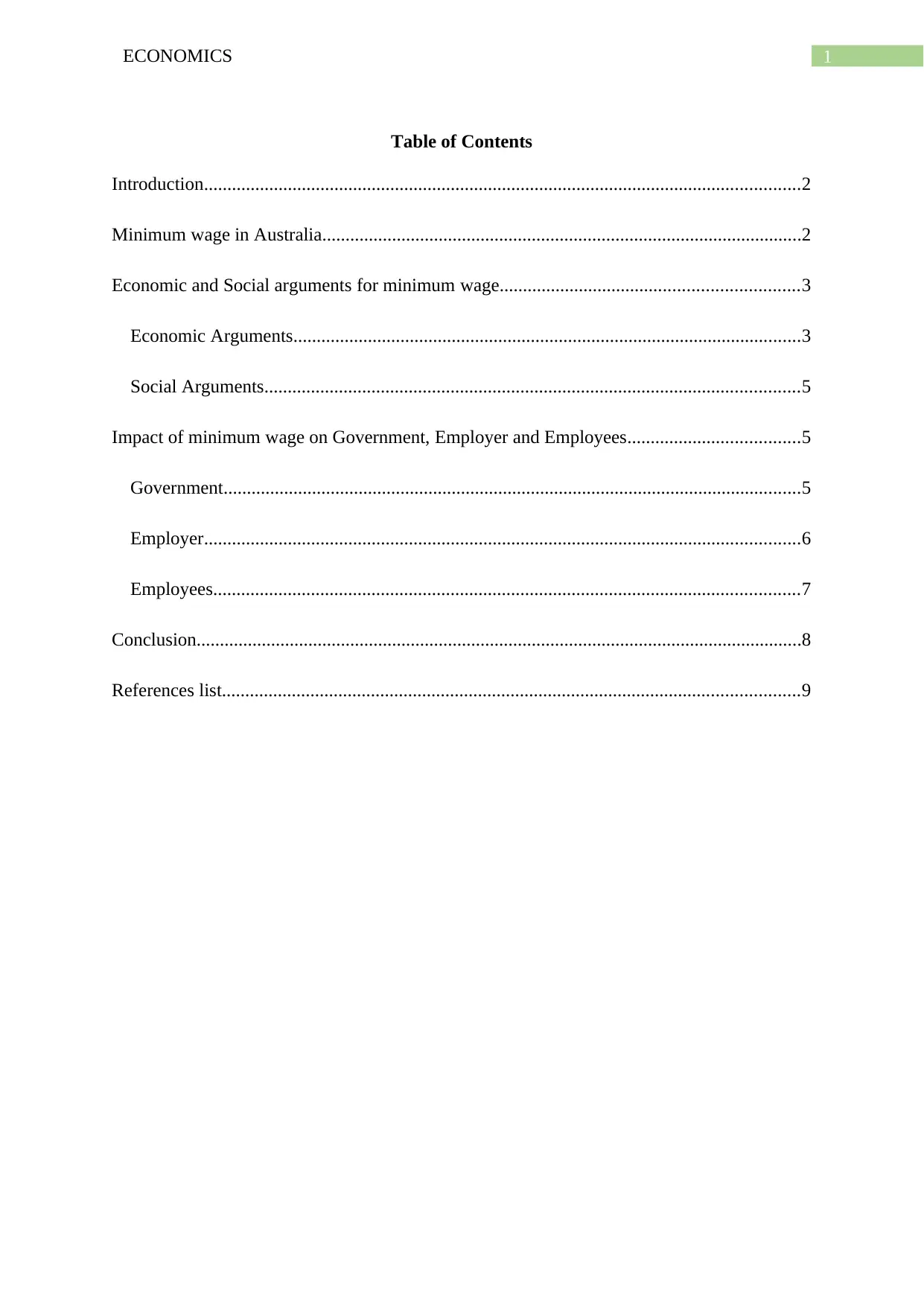
1ECONOMICS
Table of Contents
Introduction................................................................................................................................2
Minimum wage in Australia.......................................................................................................2
Economic and Social arguments for minimum wage................................................................3
Economic Arguments.............................................................................................................3
Social Arguments...................................................................................................................5
Impact of minimum wage on Government, Employer and Employees.....................................5
Government............................................................................................................................5
Employer................................................................................................................................6
Employees..............................................................................................................................7
Conclusion..................................................................................................................................8
References list............................................................................................................................9
Table of Contents
Introduction................................................................................................................................2
Minimum wage in Australia.......................................................................................................2
Economic and Social arguments for minimum wage................................................................3
Economic Arguments.............................................................................................................3
Social Arguments...................................................................................................................5
Impact of minimum wage on Government, Employer and Employees.....................................5
Government............................................................................................................................5
Employer................................................................................................................................6
Employees..............................................................................................................................7
Conclusion..................................................................................................................................8
References list............................................................................................................................9
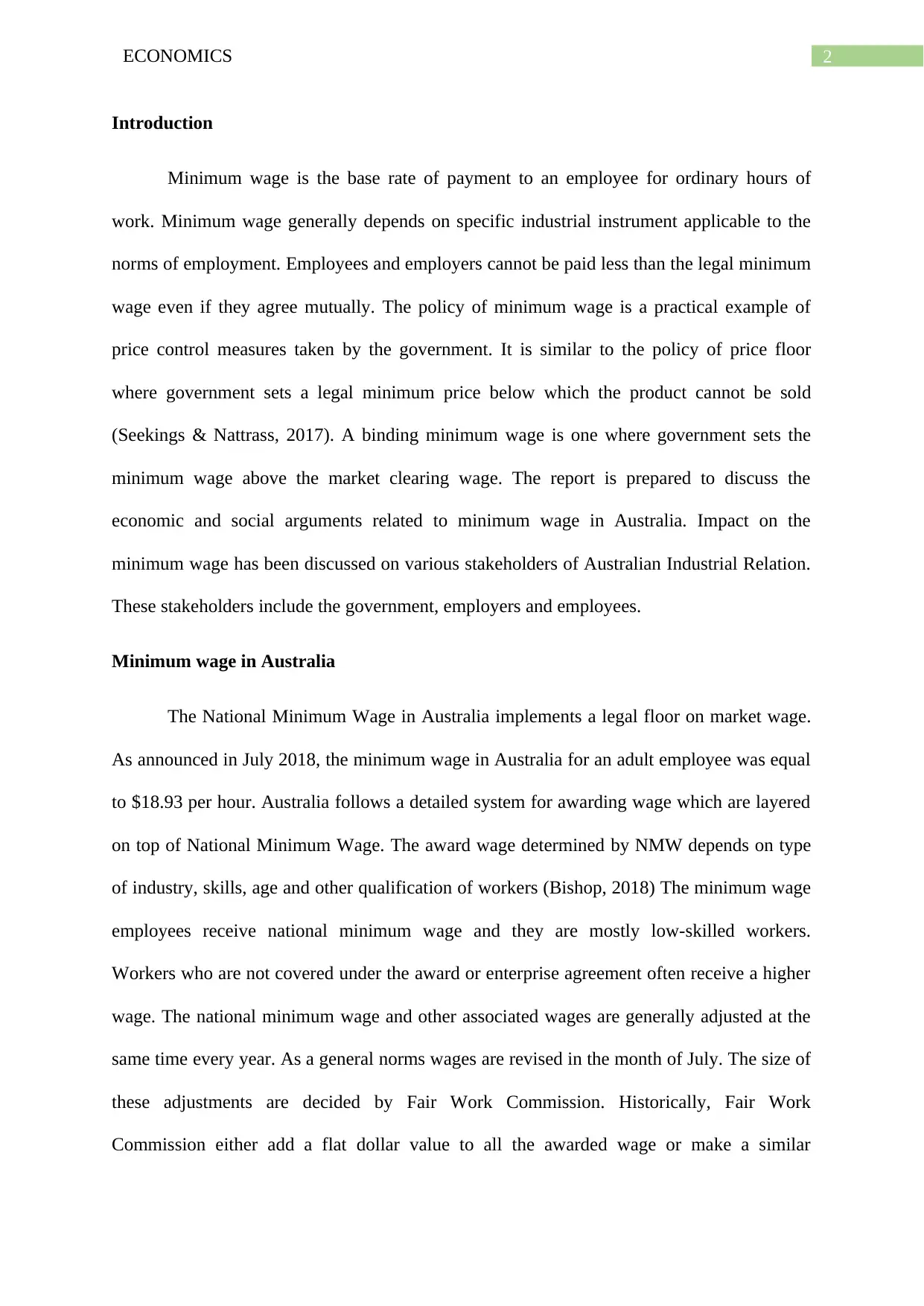
2ECONOMICS
Introduction
Minimum wage is the base rate of payment to an employee for ordinary hours of
work. Minimum wage generally depends on specific industrial instrument applicable to the
norms of employment. Employees and employers cannot be paid less than the legal minimum
wage even if they agree mutually. The policy of minimum wage is a practical example of
price control measures taken by the government. It is similar to the policy of price floor
where government sets a legal minimum price below which the product cannot be sold
(Seekings & Nattrass, 2017). A binding minimum wage is one where government sets the
minimum wage above the market clearing wage. The report is prepared to discuss the
economic and social arguments related to minimum wage in Australia. Impact on the
minimum wage has been discussed on various stakeholders of Australian Industrial Relation.
These stakeholders include the government, employers and employees.
Minimum wage in Australia
The National Minimum Wage in Australia implements a legal floor on market wage.
As announced in July 2018, the minimum wage in Australia for an adult employee was equal
to $18.93 per hour. Australia follows a detailed system for awarding wage which are layered
on top of National Minimum Wage. The award wage determined by NMW depends on type
of industry, skills, age and other qualification of workers (Bishop, 2018) The minimum wage
employees receive national minimum wage and they are mostly low-skilled workers.
Workers who are not covered under the award or enterprise agreement often receive a higher
wage. The national minimum wage and other associated wages are generally adjusted at the
same time every year. As a general norms wages are revised in the month of July. The size of
these adjustments are decided by Fair Work Commission. Historically, Fair Work
Commission either add a flat dollar value to all the awarded wage or make a similar
Introduction
Minimum wage is the base rate of payment to an employee for ordinary hours of
work. Minimum wage generally depends on specific industrial instrument applicable to the
norms of employment. Employees and employers cannot be paid less than the legal minimum
wage even if they agree mutually. The policy of minimum wage is a practical example of
price control measures taken by the government. It is similar to the policy of price floor
where government sets a legal minimum price below which the product cannot be sold
(Seekings & Nattrass, 2017). A binding minimum wage is one where government sets the
minimum wage above the market clearing wage. The report is prepared to discuss the
economic and social arguments related to minimum wage in Australia. Impact on the
minimum wage has been discussed on various stakeholders of Australian Industrial Relation.
These stakeholders include the government, employers and employees.
Minimum wage in Australia
The National Minimum Wage in Australia implements a legal floor on market wage.
As announced in July 2018, the minimum wage in Australia for an adult employee was equal
to $18.93 per hour. Australia follows a detailed system for awarding wage which are layered
on top of National Minimum Wage. The award wage determined by NMW depends on type
of industry, skills, age and other qualification of workers (Bishop, 2018) The minimum wage
employees receive national minimum wage and they are mostly low-skilled workers.
Workers who are not covered under the award or enterprise agreement often receive a higher
wage. The national minimum wage and other associated wages are generally adjusted at the
same time every year. As a general norms wages are revised in the month of July. The size of
these adjustments are decided by Fair Work Commission. Historically, Fair Work
Commission either add a flat dollar value to all the awarded wage or make a similar
⊘ This is a preview!⊘
Do you want full access?
Subscribe today to unlock all pages.

Trusted by 1+ million students worldwide

3ECONOMICS
percentage increase of all wages. The system of setting a minimum wage in Australia is more
complicated compared to other nation (Neumark, 2018). Unlike most nations where a
uniform wage is set as minimum wage, wage varies across different states of Australia.
Economic and Social arguments for minimum wage
For a considerably long period of time, Australia is leading the trend of minimum
wage. Victoria, one of the Australian states holds the second position that first introduced a
wage floor in the year 1896. Since then Australia remains the most generous state in terms of
minimum wage (Dube, Lester & Reich, 2016). There are both economic and social arguments
favoring minimum wage decision in Australia.
Economic Arguments
Minimum wage is the legal minimum wage that employers have to give to all the
hired workers. In economic terms, this is a kind of binding price floor where price is set
above the equilibrium market price. Similarly, minimum wage is well above the wage as
determined from labor demand and labor supply. An obvious consequence of minimum wage
is creation of excess supply of labor aggravating the problem of unemployment. At the higher
wage, supply of labor hour increases. Supply of labor hour increases for two reasons
(Preston, 2018) The exiting workers willing to work for more hours and new labors are
willing to enter the market at a higher wage. Demand of labor hours on the other hand
decreases as employers now face a higher cost for per unit of labor hours. This results in
excess supply of labor and unemployment which may hurt economic growth.
percentage increase of all wages. The system of setting a minimum wage in Australia is more
complicated compared to other nation (Neumark, 2018). Unlike most nations where a
uniform wage is set as minimum wage, wage varies across different states of Australia.
Economic and Social arguments for minimum wage
For a considerably long period of time, Australia is leading the trend of minimum
wage. Victoria, one of the Australian states holds the second position that first introduced a
wage floor in the year 1896. Since then Australia remains the most generous state in terms of
minimum wage (Dube, Lester & Reich, 2016). There are both economic and social arguments
favoring minimum wage decision in Australia.
Economic Arguments
Minimum wage is the legal minimum wage that employers have to give to all the
hired workers. In economic terms, this is a kind of binding price floor where price is set
above the equilibrium market price. Similarly, minimum wage is well above the wage as
determined from labor demand and labor supply. An obvious consequence of minimum wage
is creation of excess supply of labor aggravating the problem of unemployment. At the higher
wage, supply of labor hour increases. Supply of labor hour increases for two reasons
(Preston, 2018) The exiting workers willing to work for more hours and new labors are
willing to enter the market at a higher wage. Demand of labor hours on the other hand
decreases as employers now face a higher cost for per unit of labor hours. This results in
excess supply of labor and unemployment which may hurt economic growth.
Paraphrase This Document
Need a fresh take? Get an instant paraphrase of this document with our AI Paraphraser
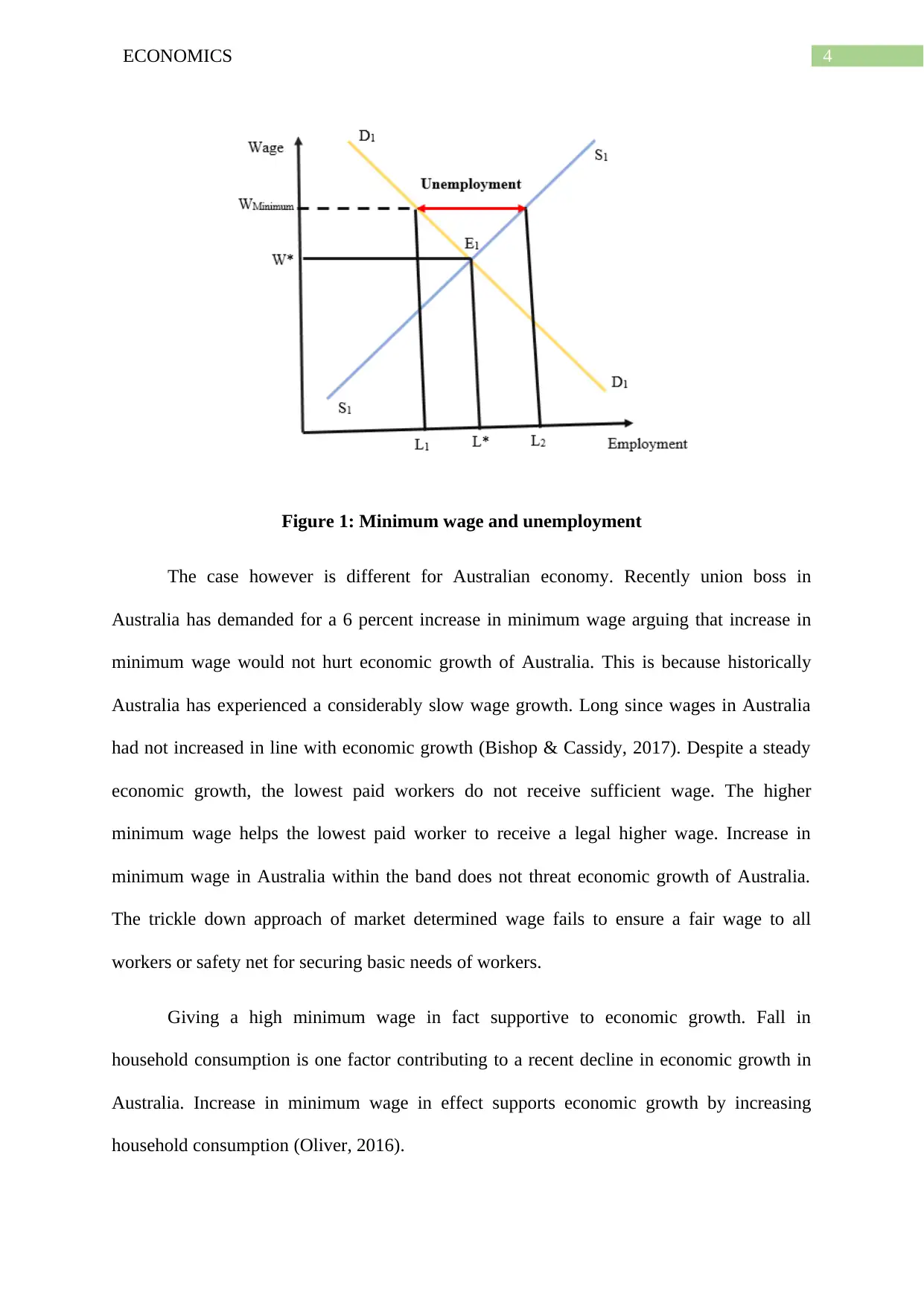
4ECONOMICS
Figure 1: Minimum wage and unemployment
The case however is different for Australian economy. Recently union boss in
Australia has demanded for a 6 percent increase in minimum wage arguing that increase in
minimum wage would not hurt economic growth of Australia. This is because historically
Australia has experienced a considerably slow wage growth. Long since wages in Australia
had not increased in line with economic growth (Bishop & Cassidy, 2017). Despite a steady
economic growth, the lowest paid workers do not receive sufficient wage. The higher
minimum wage helps the lowest paid worker to receive a legal higher wage. Increase in
minimum wage in Australia within the band does not threat economic growth of Australia.
The trickle down approach of market determined wage fails to ensure a fair wage to all
workers or safety net for securing basic needs of workers.
Giving a high minimum wage in fact supportive to economic growth. Fall in
household consumption is one factor contributing to a recent decline in economic growth in
Australia. Increase in minimum wage in effect supports economic growth by increasing
household consumption (Oliver, 2016).
Figure 1: Minimum wage and unemployment
The case however is different for Australian economy. Recently union boss in
Australia has demanded for a 6 percent increase in minimum wage arguing that increase in
minimum wage would not hurt economic growth of Australia. This is because historically
Australia has experienced a considerably slow wage growth. Long since wages in Australia
had not increased in line with economic growth (Bishop & Cassidy, 2017). Despite a steady
economic growth, the lowest paid workers do not receive sufficient wage. The higher
minimum wage helps the lowest paid worker to receive a legal higher wage. Increase in
minimum wage in Australia within the band does not threat economic growth of Australia.
The trickle down approach of market determined wage fails to ensure a fair wage to all
workers or safety net for securing basic needs of workers.
Giving a high minimum wage in fact supportive to economic growth. Fall in
household consumption is one factor contributing to a recent decline in economic growth in
Australia. Increase in minimum wage in effect supports economic growth by increasing
household consumption (Oliver, 2016).
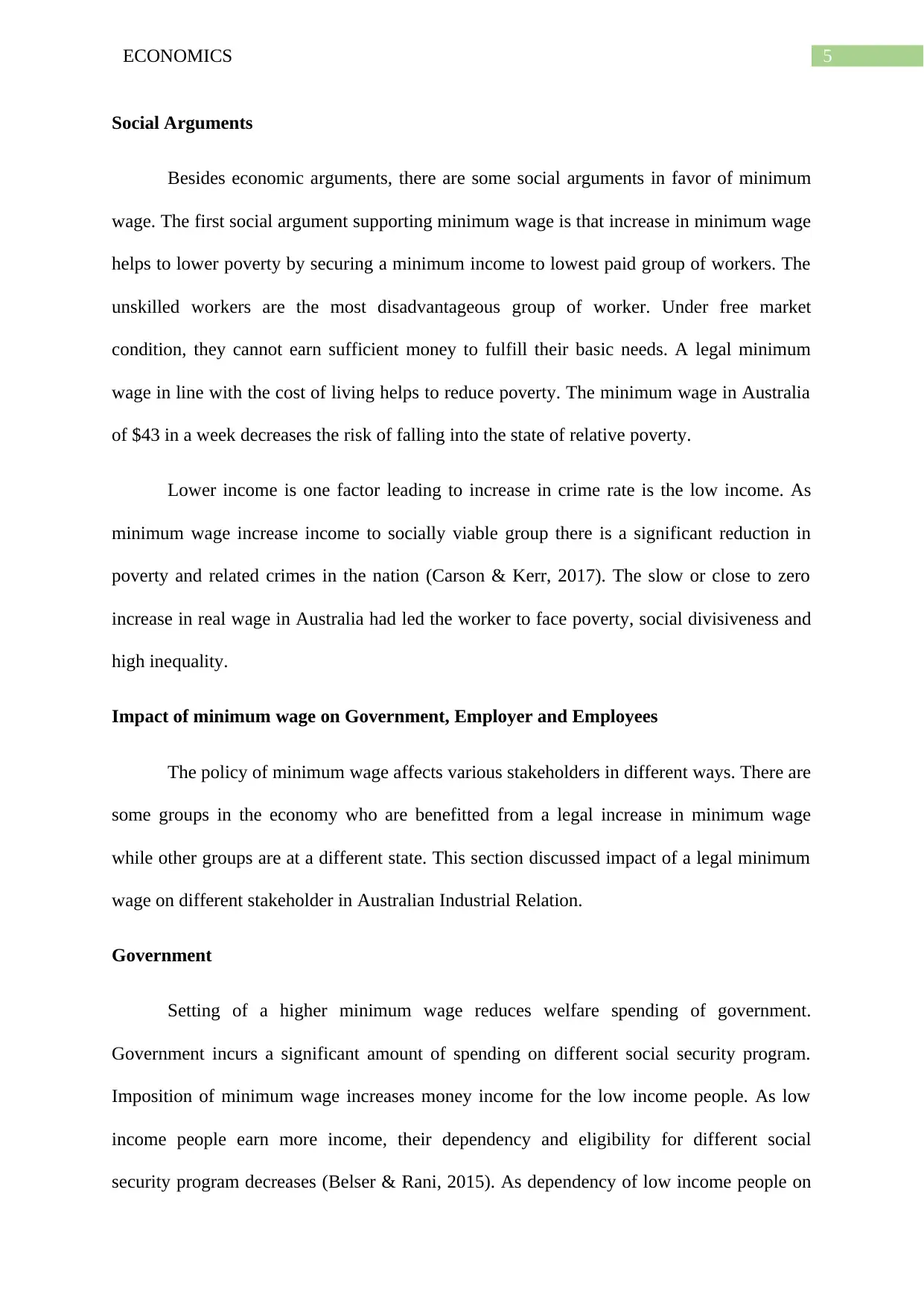
5ECONOMICS
Social Arguments
Besides economic arguments, there are some social arguments in favor of minimum
wage. The first social argument supporting minimum wage is that increase in minimum wage
helps to lower poverty by securing a minimum income to lowest paid group of workers. The
unskilled workers are the most disadvantageous group of worker. Under free market
condition, they cannot earn sufficient money to fulfill their basic needs. A legal minimum
wage in line with the cost of living helps to reduce poverty. The minimum wage in Australia
of $43 in a week decreases the risk of falling into the state of relative poverty.
Lower income is one factor leading to increase in crime rate is the low income. As
minimum wage increase income to socially viable group there is a significant reduction in
poverty and related crimes in the nation (Carson & Kerr, 2017). The slow or close to zero
increase in real wage in Australia had led the worker to face poverty, social divisiveness and
high inequality.
Impact of minimum wage on Government, Employer and Employees
The policy of minimum wage affects various stakeholders in different ways. There are
some groups in the economy who are benefitted from a legal increase in minimum wage
while other groups are at a different state. This section discussed impact of a legal minimum
wage on different stakeholder in Australian Industrial Relation.
Government
Setting of a higher minimum wage reduces welfare spending of government.
Government incurs a significant amount of spending on different social security program.
Imposition of minimum wage increases money income for the low income people. As low
income people earn more income, their dependency and eligibility for different social
security program decreases (Belser & Rani, 2015). As dependency of low income people on
Social Arguments
Besides economic arguments, there are some social arguments in favor of minimum
wage. The first social argument supporting minimum wage is that increase in minimum wage
helps to lower poverty by securing a minimum income to lowest paid group of workers. The
unskilled workers are the most disadvantageous group of worker. Under free market
condition, they cannot earn sufficient money to fulfill their basic needs. A legal minimum
wage in line with the cost of living helps to reduce poverty. The minimum wage in Australia
of $43 in a week decreases the risk of falling into the state of relative poverty.
Lower income is one factor leading to increase in crime rate is the low income. As
minimum wage increase income to socially viable group there is a significant reduction in
poverty and related crimes in the nation (Carson & Kerr, 2017). The slow or close to zero
increase in real wage in Australia had led the worker to face poverty, social divisiveness and
high inequality.
Impact of minimum wage on Government, Employer and Employees
The policy of minimum wage affects various stakeholders in different ways. There are
some groups in the economy who are benefitted from a legal increase in minimum wage
while other groups are at a different state. This section discussed impact of a legal minimum
wage on different stakeholder in Australian Industrial Relation.
Government
Setting of a higher minimum wage reduces welfare spending of government.
Government incurs a significant amount of spending on different social security program.
Imposition of minimum wage increases money income for the low income people. As low
income people earn more income, their dependency and eligibility for different social
security program decreases (Belser & Rani, 2015). As dependency of low income people on
⊘ This is a preview!⊘
Do you want full access?
Subscribe today to unlock all pages.

Trusted by 1+ million students worldwide

6ECONOMICS
government assistance program reduces, burden on government burden for spending on
different social security program reduces. The saved money from federal budget can
therefore be spent on other productive purposes. The report of Federal government shows that
increase in minimum wage by $50 a week can create a jobs up to 87,000 within the first two
years of wage increase (Karp, 2018). In support of minimum wage, Unions have argued that
the low paid workers mostly spend their extra income on different expenditures. This in turn
boost aggregate demand of the economy and creates more job opportunities. As new job
opportunities are created there is a tendency to lower unemployment. As unemployment
decreases, government needs to spend lower on unemployment benefits or creating more
jobs. Government estimates the number of job creation in the first year to be 57000 and that
in the second year to be 30000 in the second year. Federal government finds it useful to
increase the minimum wage as increases aggregate demand of the economy by mostly
increasing spending by low income households.
Employer
The Australian Council of Trade Unions support an increase in minimum wage on the
ground that without an increase in wages, the Australian economy will likely to suffer
inequality. The prevalent low wage will restrict the growth potential of the economy. The
employers or business groups however hold a different view. Employers always support for a
relatively smaller increase in minimum wage (Card & Krueger, 2015). They consider
excessive increase in minimum wage is unnecessary as this put businesses at risk by
increasing the burden of wage cost. Higher minimum wage reduces profit margin of
employers by forcing them to pay a high salary and wages as a proportion of their total
expense and reduces survival rate. The proposed increase in minimum wage is likely to put
the employers in a tough condition. Increase in minimum wage generally discourage the
employers to hire low skilled workers. Survey conducted on retail industry of Australia
government assistance program reduces, burden on government burden for spending on
different social security program reduces. The saved money from federal budget can
therefore be spent on other productive purposes. The report of Federal government shows that
increase in minimum wage by $50 a week can create a jobs up to 87,000 within the first two
years of wage increase (Karp, 2018). In support of minimum wage, Unions have argued that
the low paid workers mostly spend their extra income on different expenditures. This in turn
boost aggregate demand of the economy and creates more job opportunities. As new job
opportunities are created there is a tendency to lower unemployment. As unemployment
decreases, government needs to spend lower on unemployment benefits or creating more
jobs. Government estimates the number of job creation in the first year to be 57000 and that
in the second year to be 30000 in the second year. Federal government finds it useful to
increase the minimum wage as increases aggregate demand of the economy by mostly
increasing spending by low income households.
Employer
The Australian Council of Trade Unions support an increase in minimum wage on the
ground that without an increase in wages, the Australian economy will likely to suffer
inequality. The prevalent low wage will restrict the growth potential of the economy. The
employers or business groups however hold a different view. Employers always support for a
relatively smaller increase in minimum wage (Card & Krueger, 2015). They consider
excessive increase in minimum wage is unnecessary as this put businesses at risk by
increasing the burden of wage cost. Higher minimum wage reduces profit margin of
employers by forcing them to pay a high salary and wages as a proportion of their total
expense and reduces survival rate. The proposed increase in minimum wage is likely to put
the employers in a tough condition. Increase in minimum wage generally discourage the
employers to hire low skilled workers. Survey conducted on retail industry of Australia
Paraphrase This Document
Need a fresh take? Get an instant paraphrase of this document with our AI Paraphraser

7ECONOMICS
shows that employers support a rise in minimum wage which nearly equals rate of inflation
as measured by consumer price index (Triscari, 2019). Because of a higher wage employers
group have to struggle to keep up production at the same scale and need to consider a decline
in workers’ strength. This in turn force them to contract scale of production.
Employees
The legal minimum wage is set to secure a minimum income to the employees. It is
designed to increase well-being of the group of workers. However, the minimum wage law
has both positive and negative impacts on employees. In the absence of minimum wage,
employee receive wages as determined from labor demand and labor supply. The impact of
minimum wage differs among various worker group (MaCurdy, 2015). Skilled employees
generally receive a high wage (above the minimum wage). For these group of workers,
minimum wage does not have any impact. The low skilled workers however receive only
equilibrium wage or below the equilibrium wage. For this group, imposition of minimum
wage above the equilibrium wage increases income of these group. The higher income to the
employees however come at the consequence of unemployment. Increase in minimum wage
increases cost of employers to pay salaries and wages to employees. At the higher wage
supply of labor increases while demand for labor from employers’ side fall. In order to reduce
wage cost employers, decide to lay off workers (Bell & Machin, 2018). This results in
unemployment among the workers in the organization. Low skilled employees mostly face
the consequence of unemployment as they receive wage close to market clearing wage. In
Australia, it is however argued that considerable increase in minimum wage does not jobs.
The research paper of Reserve Bank of Australia claims that modest increase in minimum
wage do no harm either jobs or job hours in Australia. The consequences however can be
changed and employees may suffer for a large anticipated change in wage. In order to explain
the position of employees for a given increase in minimum wage labor argued that wage
shows that employers support a rise in minimum wage which nearly equals rate of inflation
as measured by consumer price index (Triscari, 2019). Because of a higher wage employers
group have to struggle to keep up production at the same scale and need to consider a decline
in workers’ strength. This in turn force them to contract scale of production.
Employees
The legal minimum wage is set to secure a minimum income to the employees. It is
designed to increase well-being of the group of workers. However, the minimum wage law
has both positive and negative impacts on employees. In the absence of minimum wage,
employee receive wages as determined from labor demand and labor supply. The impact of
minimum wage differs among various worker group (MaCurdy, 2015). Skilled employees
generally receive a high wage (above the minimum wage). For these group of workers,
minimum wage does not have any impact. The low skilled workers however receive only
equilibrium wage or below the equilibrium wage. For this group, imposition of minimum
wage above the equilibrium wage increases income of these group. The higher income to the
employees however come at the consequence of unemployment. Increase in minimum wage
increases cost of employers to pay salaries and wages to employees. At the higher wage
supply of labor increases while demand for labor from employers’ side fall. In order to reduce
wage cost employers, decide to lay off workers (Bell & Machin, 2018). This results in
unemployment among the workers in the organization. Low skilled employees mostly face
the consequence of unemployment as they receive wage close to market clearing wage. In
Australia, it is however argued that considerable increase in minimum wage does not jobs.
The research paper of Reserve Bank of Australia claims that modest increase in minimum
wage do no harm either jobs or job hours in Australia. The consequences however can be
changed and employees may suffer for a large anticipated change in wage. In order to explain
the position of employees for a given increase in minimum wage labor argued that wage
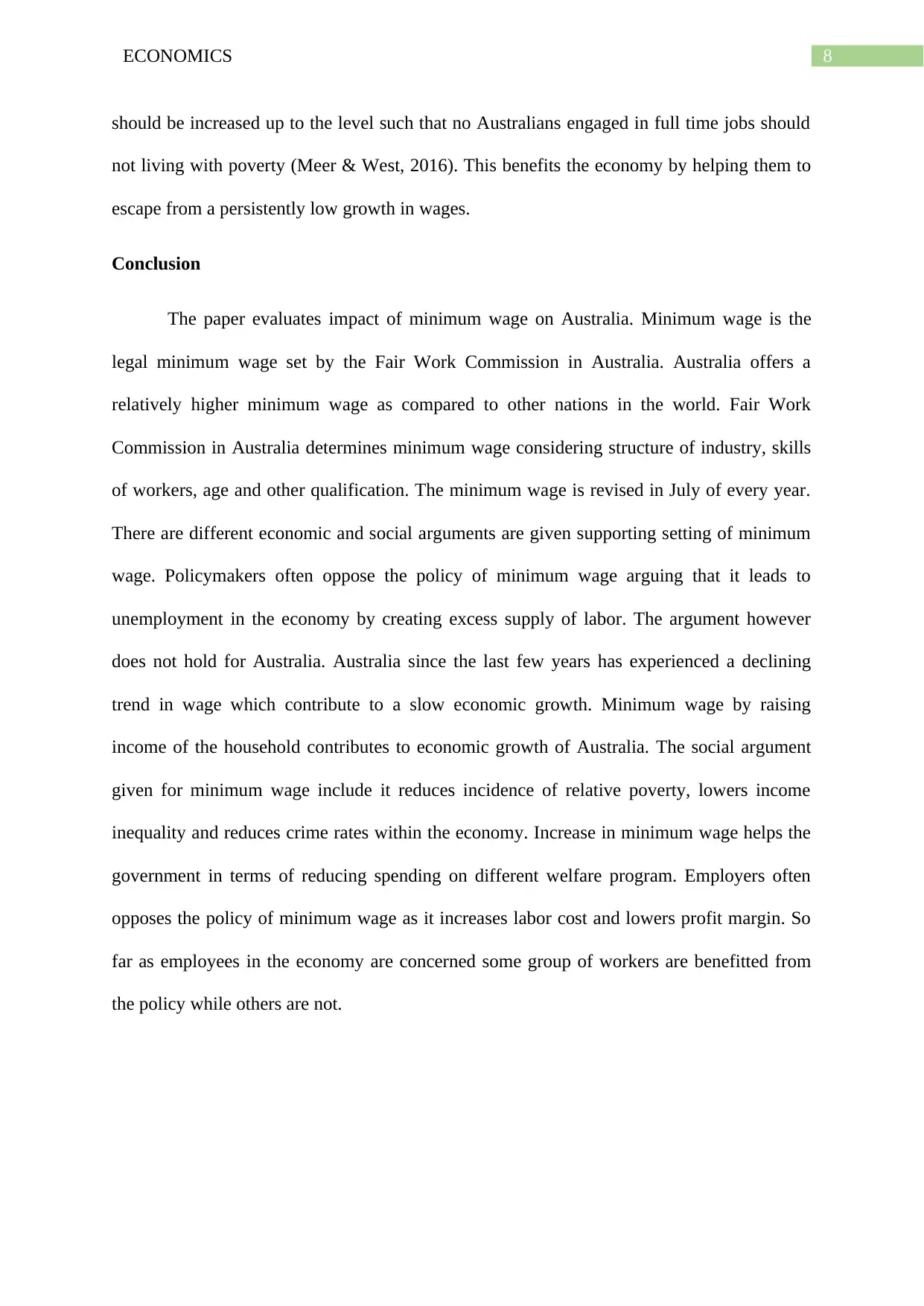
8ECONOMICS
should be increased up to the level such that no Australians engaged in full time jobs should
not living with poverty (Meer & West, 2016). This benefits the economy by helping them to
escape from a persistently low growth in wages.
Conclusion
The paper evaluates impact of minimum wage on Australia. Minimum wage is the
legal minimum wage set by the Fair Work Commission in Australia. Australia offers a
relatively higher minimum wage as compared to other nations in the world. Fair Work
Commission in Australia determines minimum wage considering structure of industry, skills
of workers, age and other qualification. The minimum wage is revised in July of every year.
There are different economic and social arguments are given supporting setting of minimum
wage. Policymakers often oppose the policy of minimum wage arguing that it leads to
unemployment in the economy by creating excess supply of labor. The argument however
does not hold for Australia. Australia since the last few years has experienced a declining
trend in wage which contribute to a slow economic growth. Minimum wage by raising
income of the household contributes to economic growth of Australia. The social argument
given for minimum wage include it reduces incidence of relative poverty, lowers income
inequality and reduces crime rates within the economy. Increase in minimum wage helps the
government in terms of reducing spending on different welfare program. Employers often
opposes the policy of minimum wage as it increases labor cost and lowers profit margin. So
far as employees in the economy are concerned some group of workers are benefitted from
the policy while others are not.
should be increased up to the level such that no Australians engaged in full time jobs should
not living with poverty (Meer & West, 2016). This benefits the economy by helping them to
escape from a persistently low growth in wages.
Conclusion
The paper evaluates impact of minimum wage on Australia. Minimum wage is the
legal minimum wage set by the Fair Work Commission in Australia. Australia offers a
relatively higher minimum wage as compared to other nations in the world. Fair Work
Commission in Australia determines minimum wage considering structure of industry, skills
of workers, age and other qualification. The minimum wage is revised in July of every year.
There are different economic and social arguments are given supporting setting of minimum
wage. Policymakers often oppose the policy of minimum wage arguing that it leads to
unemployment in the economy by creating excess supply of labor. The argument however
does not hold for Australia. Australia since the last few years has experienced a declining
trend in wage which contribute to a slow economic growth. Minimum wage by raising
income of the household contributes to economic growth of Australia. The social argument
given for minimum wage include it reduces incidence of relative poverty, lowers income
inequality and reduces crime rates within the economy. Increase in minimum wage helps the
government in terms of reducing spending on different welfare program. Employers often
opposes the policy of minimum wage as it increases labor cost and lowers profit margin. So
far as employees in the economy are concerned some group of workers are benefitted from
the policy while others are not.
⊘ This is a preview!⊘
Do you want full access?
Subscribe today to unlock all pages.

Trusted by 1+ million students worldwide

9ECONOMICS
References list
Bell, B., & Machin, S. (2018). Minimum wages and firm value. Journal of Labor
Economics, 36(1), 159-195.
Belser, P., & Rani, U. (2015). Minimum wages and inequality. Labour Markets, institutions
and inequality: building just societies in the 21st century, Cheltenham: Edward Elgar,
123-146.
Bishop, J. (2018). The Effect of Minimum Wage Increases on Wages, Hours Worked and Job
Loss | Bulletin – September Quarter 2018. Bulletin, (September). Retrieved from
https://rba.gov.au/publications/bulletin/2018/sep/the-effect-of-minimum-wage-
increases-on-wages-hours-worked-and-job-loss.html
Bishop, J., & Cassidy, N. (2017). Insights into low wage growth in Australia. RBA Bulletin,
March, 13-20.
Card, D., & Krueger, A. B. (2015). Myth and Measurement: The New Economics of the
Minimum Wage-Twentieth-Anniversary Edition. Princeton University Press.
Carson, E., & Kerr, L. (2017). Australian social policy and the human services. Cambridge
University Press.
Dube, A., Lester, T. W., & Reich, M. (2016). Minimum wage shocks, employment flows, and
labor market frictions. Journal of Labor Economics, 34(3), 663-704.
Karp, P. (2018). $50-a-week wage rise would create up to 87,000 jobs, unions say. the
Guardian. Retrieved 25 August 2019, from https://www.theguardian.com/australia-
news/2018/apr/19/50-a-week-wage-rise-would-create-up-to-87000-jobs-unions-say
MaCurdy, T. (2015). How effective is the minimum wage at supporting the poor?. Journal of
Political Economy, 123(2), 497-545.
References list
Bell, B., & Machin, S. (2018). Minimum wages and firm value. Journal of Labor
Economics, 36(1), 159-195.
Belser, P., & Rani, U. (2015). Minimum wages and inequality. Labour Markets, institutions
and inequality: building just societies in the 21st century, Cheltenham: Edward Elgar,
123-146.
Bishop, J. (2018). The Effect of Minimum Wage Increases on Wages, Hours Worked and Job
Loss | Bulletin – September Quarter 2018. Bulletin, (September). Retrieved from
https://rba.gov.au/publications/bulletin/2018/sep/the-effect-of-minimum-wage-
increases-on-wages-hours-worked-and-job-loss.html
Bishop, J., & Cassidy, N. (2017). Insights into low wage growth in Australia. RBA Bulletin,
March, 13-20.
Card, D., & Krueger, A. B. (2015). Myth and Measurement: The New Economics of the
Minimum Wage-Twentieth-Anniversary Edition. Princeton University Press.
Carson, E., & Kerr, L. (2017). Australian social policy and the human services. Cambridge
University Press.
Dube, A., Lester, T. W., & Reich, M. (2016). Minimum wage shocks, employment flows, and
labor market frictions. Journal of Labor Economics, 34(3), 663-704.
Karp, P. (2018). $50-a-week wage rise would create up to 87,000 jobs, unions say. the
Guardian. Retrieved 25 August 2019, from https://www.theguardian.com/australia-
news/2018/apr/19/50-a-week-wage-rise-would-create-up-to-87000-jobs-unions-say
MaCurdy, T. (2015). How effective is the minimum wage at supporting the poor?. Journal of
Political Economy, 123(2), 497-545.
Paraphrase This Document
Need a fresh take? Get an instant paraphrase of this document with our AI Paraphraser

10ECONOMICS
Meer, J., & West, J. (2016). Effects of the minimum wage on employment dynamics. Journal
of Human Resources, 51(2), 500-522.
Neumark, D. (2018). Employment effects of minimum wages. IZA World of Labor.
Neumark, D., & Wascher, W. (2017). Reply to “credible research designs for minimum wage
studies”. ILR Review, 70(3), 593-609.
Oliver, D. (2016). Wage determination in Australia: The impact of qualifications, awards and
enterprise agreements. Journal of Industrial Relations, 58(1), 69-92.
Preston, A. (2018). The structure and determinants of wage relativities: evidence from
Australia. Routledge.
Seekings, J., & Nattrass, N. (2015). What is at issue in the minimum wage debate. Cape
Town: Development Policy Research Unit, University of Cape Town.
Triscari, C. (2019). Minimum wage debate: What do small businesses want? -
SmartCompany. Retrieved 25 August 2019, from
https://www.smartcompany.com.au/finance/economy/minimum-wage-debate-small-
business/
Meer, J., & West, J. (2016). Effects of the minimum wage on employment dynamics. Journal
of Human Resources, 51(2), 500-522.
Neumark, D. (2018). Employment effects of minimum wages. IZA World of Labor.
Neumark, D., & Wascher, W. (2017). Reply to “credible research designs for minimum wage
studies”. ILR Review, 70(3), 593-609.
Oliver, D. (2016). Wage determination in Australia: The impact of qualifications, awards and
enterprise agreements. Journal of Industrial Relations, 58(1), 69-92.
Preston, A. (2018). The structure and determinants of wage relativities: evidence from
Australia. Routledge.
Seekings, J., & Nattrass, N. (2015). What is at issue in the minimum wage debate. Cape
Town: Development Policy Research Unit, University of Cape Town.
Triscari, C. (2019). Minimum wage debate: What do small businesses want? -
SmartCompany. Retrieved 25 August 2019, from
https://www.smartcompany.com.au/finance/economy/minimum-wage-debate-small-
business/
1 out of 11
Related Documents
Your All-in-One AI-Powered Toolkit for Academic Success.
+13062052269
info@desklib.com
Available 24*7 on WhatsApp / Email
![[object Object]](/_next/static/media/star-bottom.7253800d.svg)
Unlock your academic potential
Copyright © 2020–2025 A2Z Services. All Rights Reserved. Developed and managed by ZUCOL.




